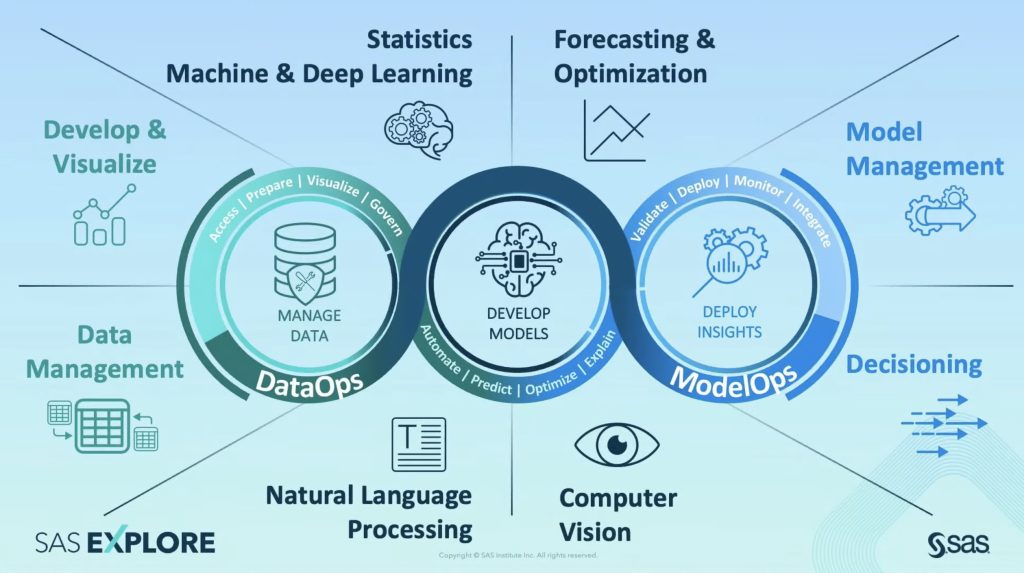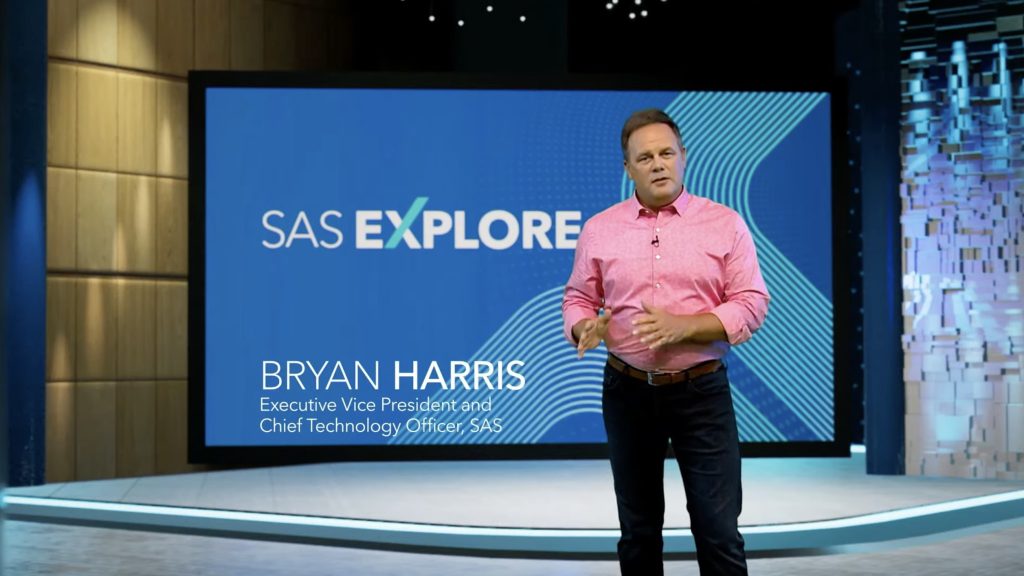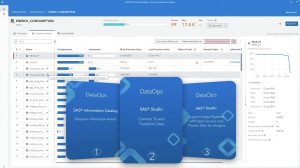More digital channels are bringing greater connectivity and more data is bringing added complexity to organizations. All this can feel chaotic or like a fog of information warfare. As a result, the pace of disruption and data expansion require visual tools that accelerate data wrangling and modeling.
To overcome complexity, organizations need an analytics and AI platform that drives productivity and business outcomes. The hyperconnectivity and complexity of data today demand productivity.
But what does this mean for employees?
- If you’re in IT, you need to configure and optimize environments for agility.
- If you’re a data engineer, you need to collect, manage and convert data to be analytically ready.
- If you’re a data scientist, you need to work with large data sets to solve complex problems as quickly as possible.
- If you’re a business analyst, you need tools to gain insights quickly and solve the biggest challenges for your business.
During the SAS Explore Opening Session, Chief Technology Officer Bryan Harris spoke about the value of working with a persistent data and analytics strategy to drive results, and he left listeners with three principles for achieving productivity: simplicity, transparency and efficiency. In short, model development must be efficient, automated and explainable to drive adoption. Think of these as critical components of the analytics life cycle.
Since collaboration enables productivity, too, it was fitting that other SAS research and development leaders joined Harris to demonstrate the end-to-end capabilities of SAS® Viya®. The demos further emphasized how these principles can help organizations quickly overcome complexities in implementing analytics. Keep reading to see photos from the event and to read quotes from the demonstrators about the value of productivity.
1. Productivity means simplicity
The goal is to overcome complexity with simplicity. When it comes to analytics, simplicity is accomplished with comprehensive capabilities.
Harris talked about the many ways simplicity can help overcome complexity and improve the use of AI throughout the organization. In the quotes below, you'll read how he and Shadi Shahin discuss the benefits of simplicity, especially when it comes to deploying analytics.


Shahin believes that as we remove barriers to entry to analytics, barriers between practitioners of separate disciplines should be removed. That means adding capabilities in your analytics platform that speak to the different roles in your organization. For example, as Shahin continued, "The handoff between a data engineer and a business intelligence engineer needs to feel natural."

2. Productivity means efficiency
If you are more efficient, chances are you can see the future faster.
But how does this translate to the world of ModelOps and AI? Today, 90% of models never make it to production. In this day and age, you can’t afford prolonged IT projects and science experiments.

There’s a lot of moving parts in the analytics lifecycle and that all starts with probably the most daunting and often most time consuming, stage: finding and preparing your data for analysis. All organizations nowadays have access to a wide array of data sources, including cloud and on-premise databases, different file formats and other sources.
At the demo desk, Jess Faust, Test Engineer in Research & Development demonstrated SAS® Information Catalog and SAS® Data Studio and showed how teams can automatically index and profile any data source on an ad hoc basis.


With SAS Information Catalog, teams can browse and discover different types of assets produced across their organization. For example, Faust showed how quickly teams can understand the most popular data sources, see how many data pipelines and models exist and gauge how well their organization is utilizing the data available to them.
3. Productivity means transparency
Trust demands transparency; therefore, transparency requires traceability.
The decisions made by AI are the outcome of algorithms, data and business processes. This means transparency must be applied in each area to ensure responsible innovation.
It’s important to understand that AI studies the past to make decisions for the present and future. But if data from the past is biased or underrepresented, then AI could perpetuate future decisions that are also biased and have unintended consequences. As AI becomes more pervasive in society, automated decisions are being made on behalf of large populations. These outcomes must be explainable, transparent and fair.


– Brett Wujek, Sr. Manager, Product Management
In the last step, Product Manager Sophia Rowland showed how SAS Container Runtime provides a lightweight and open containerized approach for model and decision deployment.

Rowland walked through how to manage models, incorporate models into a decision, how to put that decision into a container and how to put that container into production. She then showed how to use that container within production and how to monitor the ModelOps process effectively over time to ensure models are continuing to help make valuable decisions.
Moving forward
In the demo, data scientists and engineers deployed a containerized decision into SAS Viya's production environment in just a few minutes. That process could take a team weeks, which reinforces the efficiency of the platform. Second, the demo showed how SAS and open source models can be managed, deployed and monitored from the same tool.
Lastly, the team showed how you can save countless hours of IT and engineering time because SAS Container Runtime provides portability and ease of integration across multiple deployment environments.
“The market is littered with buzzwords and unmet promises with AI. SAS cuts through the hype and enables you to get real work done. No other AI company has deployed more models into production for more customers. That is because we have the most productive analytics and AI platform. And there is no compression algorithm for experience. When you choose SAS, you are limitless in your ability to discover new insights, solve problems and move the world forward.”
– Bryan Harris
SAS Viya can provide the end-to-end productivity organizations needs to overcome data wrangling and modeling challenges.

